
Office furniture manufacturer MillerKnoll (NASDAQ: MLKN) announced better-than-expected revenue in Q3 CY2025, with sales up 10.9% year on year to $955.7 million. On the other hand, next quarter’s revenue guidance of $946 million was less impressive, coming in 1.5% below analysts’ estimates. Its non-GAAP profit of $0.45 per share was 31.1% above analysts’ consensus estimates.
Is now the time to buy MillerKnoll? Find out by accessing our full research report, it’s free.
MillerKnoll (MLKN) Q3 CY2025 Highlights:
- Revenue: $955.7 million vs analyst estimates of $911 million (10.9% year-on-year growth, 4.9% beat)
- Adjusted EPS: $0.45 vs analyst estimates of $0.34 (31.1% beat)
- Revenue Guidance for Q4 CY2025 is $946 million at the midpoint, below analyst estimates of $960.7 million
- Adjusted EPS guidance for Q4 CY2025 is $0.41 at the midpoint, below analyst estimates of $0.41
- Operating Margin: 5.6%, in line with the same quarter last year
- Backlog: $690.9 million at quarter end
- Market Capitalization: $1.36 billion
Company Overview
Created through the 2021 merger of industry icons Herman Miller and Knoll, MillerKnoll (NASDAQ: MLKN) designs, manufactures, and distributes interior furnishings for offices, healthcare facilities, educational settings, and homes worldwide.
Revenue Growth
A company’s long-term sales performance can indicate its overall quality. Any business can put up a good quarter or two, but the best consistently grow over the long haul.
With $3.76 billion in revenue over the past 12 months, MillerKnoll is a mid-sized business services company, which sometimes brings disadvantages compared to larger competitors benefiting from better economies of scale. On the bright side, it can still flex high growth rates because it’s working from a smaller revenue base.
As you can see below, MillerKnoll’s sales grew at an impressive 9% compounded annual growth rate over the last five years. This shows it had high demand, a useful starting point for our analysis.
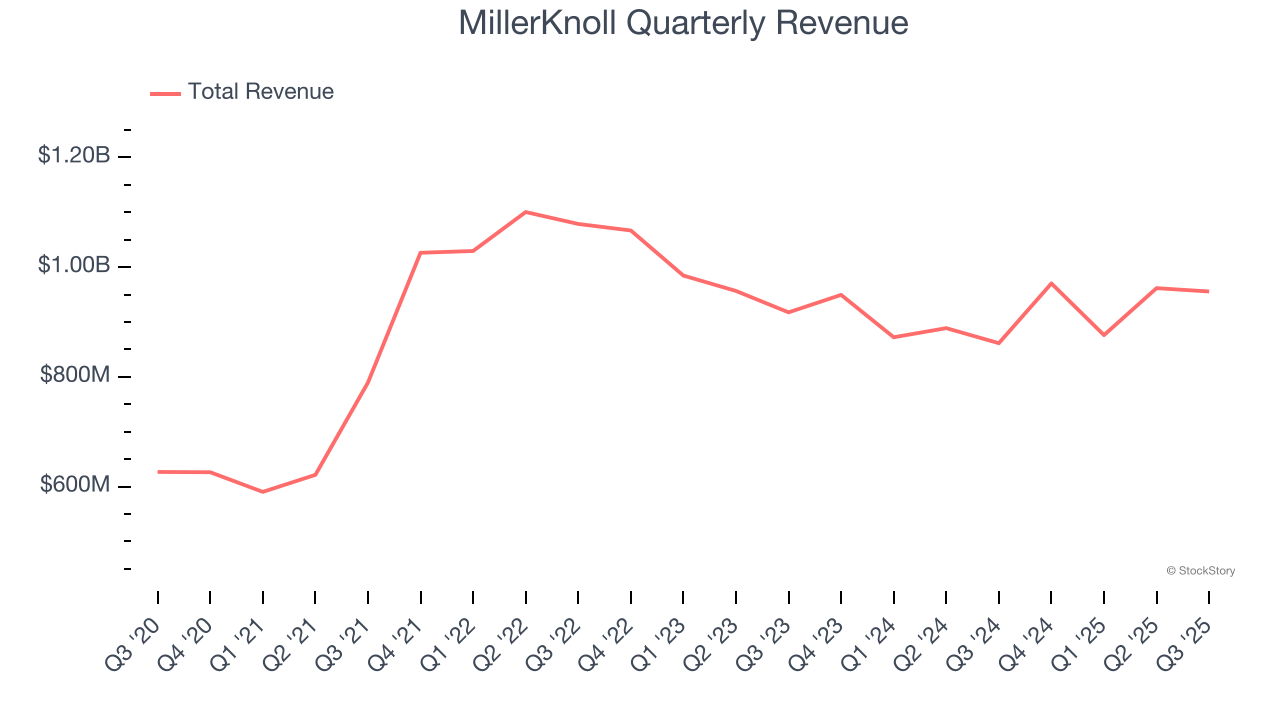
We at StockStory place the most emphasis on long-term growth, but within business services, a half-decade historical view may miss recent innovations or disruptive industry trends. MillerKnoll’s recent performance marks a sharp pivot from its five-year trend as its revenue has shown annualized declines of 2.1% over the last two years. 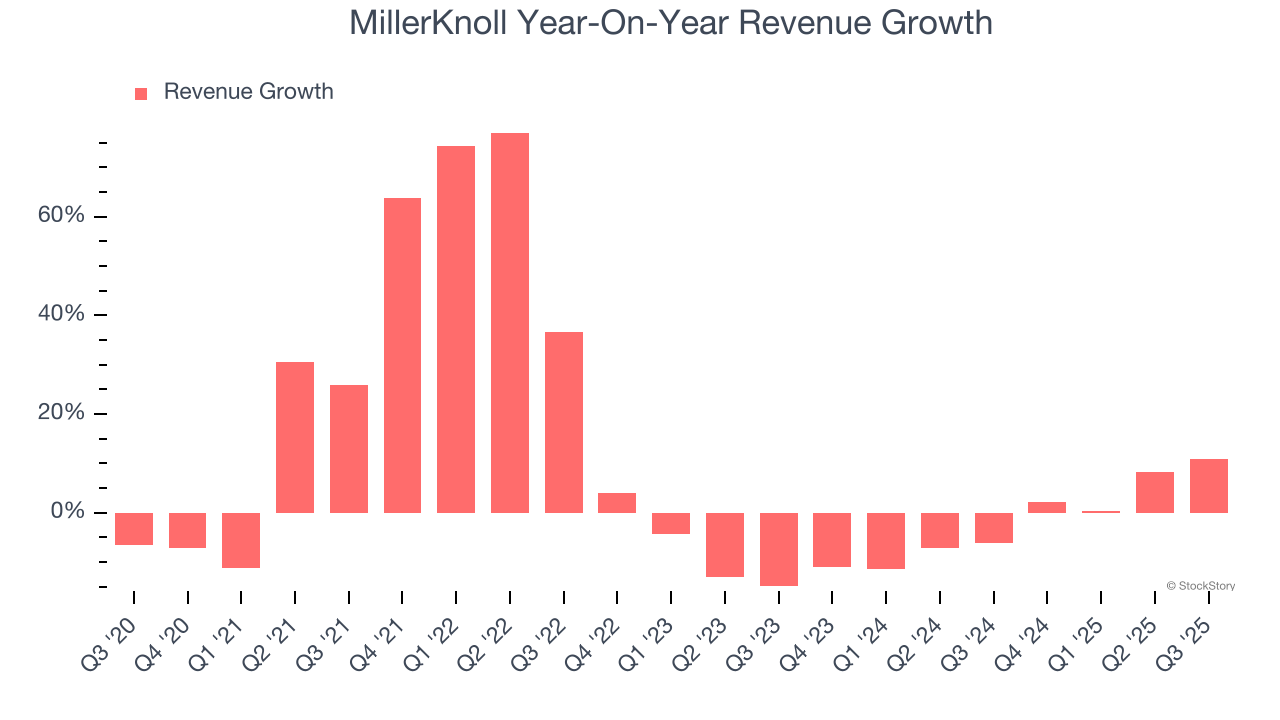
This quarter, MillerKnoll reported year-on-year revenue growth of 10.9%, and its $955.7 million of revenue exceeded Wall Street’s estimates by 4.9%. Company management is currently guiding for a 2.5% year-on-year decline in sales next quarter.
Looking further ahead, sell-side analysts expect revenue to grow 1.8% over the next 12 months. Although this projection suggests its newer products and services will spur better top-line performance, it is still below the sector average.
Today’s young investors won’t have read the timeless lessons in Gorilla Game: Picking Winners In High Technology because it was written more than 20 years ago when Microsoft and Apple were first establishing their supremacy. But if we apply the same principles, then enterprise software stocks leveraging their own generative AI capabilities may well be the Gorillas of the future. So, in that spirit, we are excited to present our Special Free Report on a profitable, fast-growing enterprise software stock that is already riding the automation wave and looking to catch the generative AI next.
Operating Margin
MillerKnoll was profitable over the last five years but held back by its large cost base. Its average operating margin of 5.7% was weak for a business services business.
On the plus side, MillerKnoll’s operating margin rose by 1.9 percentage points over the last five years, as its sales growth gave it operating leverage.
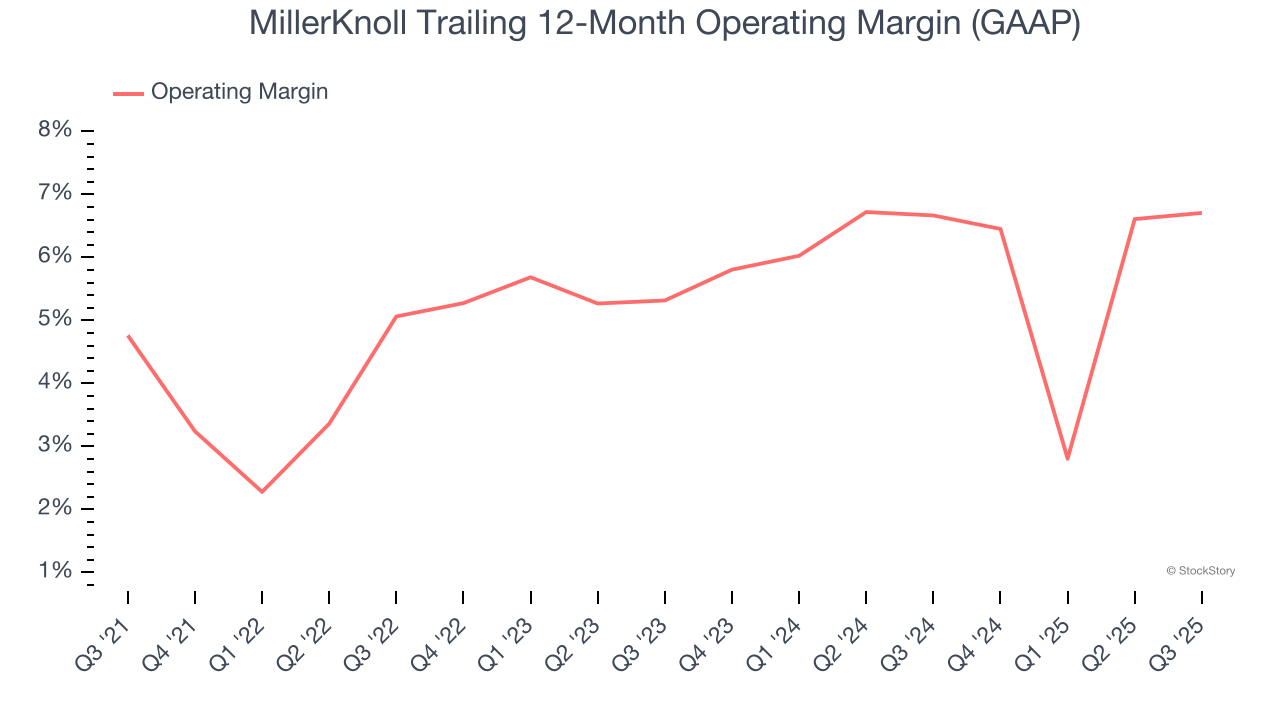
In Q3, MillerKnoll generated an operating margin profit margin of 5.6%, in line with the same quarter last year. This indicates the company’s overall cost structure has been relatively stable.
Earnings Per Share
Revenue trends explain a company’s historical growth, but the long-term change in earnings per share (EPS) points to the profitability of that growth – for example, a company could inflate its sales through excessive spending on advertising and promotions.
Sadly for MillerKnoll, its EPS declined by 7.2% annually over the last five years while its revenue grew by 9%. However, its operating margin actually improved during this time, telling us that non-fundamental factors such as interest expenses and taxes affected its ultimate earnings.
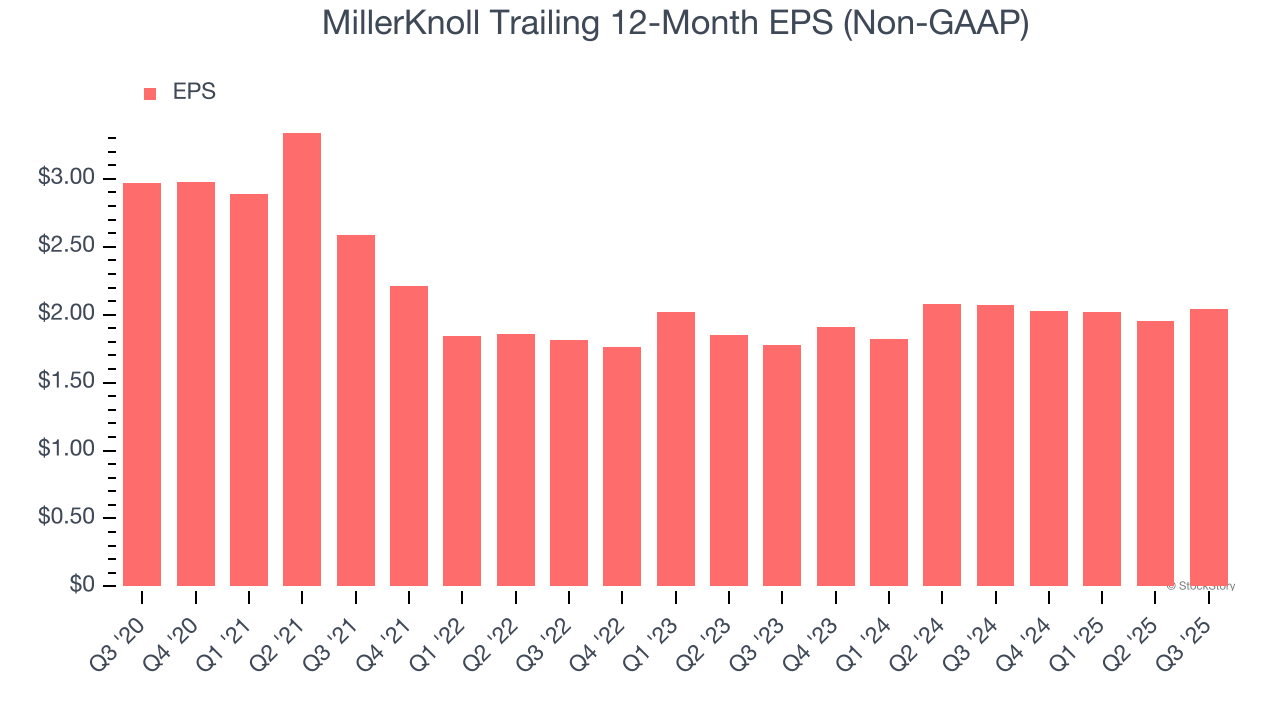
We can take a deeper look into MillerKnoll’s earnings to better understand the drivers of its performance. A five-year view shows MillerKnoll has diluted its shareholders, growing its share count by 17.3%. This dilution overshadowed its increased operational efficiency and has led to lower per share earnings. Taxes and interest expenses can also affect EPS but don’t tell us as much about a company’s fundamentals. 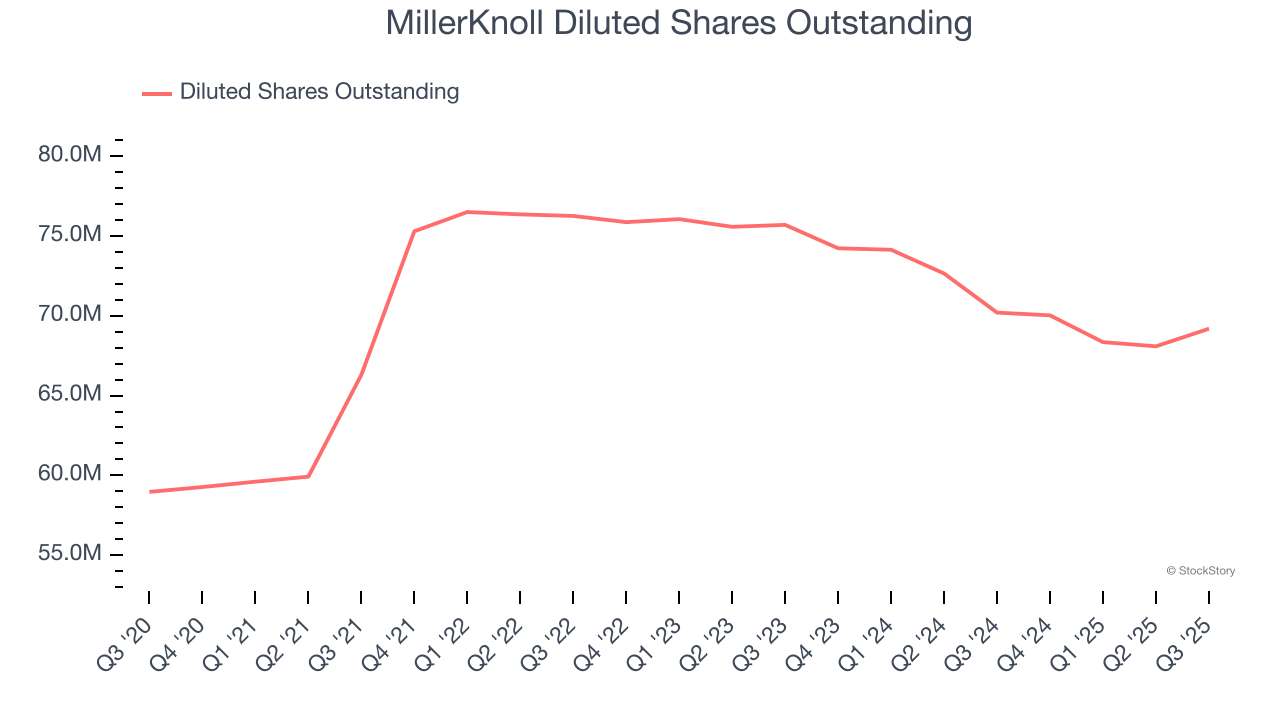
Like with revenue, we analyze EPS over a more recent period because it can provide insight into an emerging theme or development for the business.
For MillerKnoll, its two-year annual EPS growth of 7.1% was higher than its five-year trend. Accelerating earnings growth is almost always an encouraging data point.
In Q3, MillerKnoll reported adjusted EPS of $0.45, up from $0.36 in the same quarter last year. This print easily cleared analysts’ estimates, and shareholders should be content with the results. Over the next 12 months, Wall Street expects MillerKnoll’s full-year EPS of $2.04 to shrink by 3.4%.
Key Takeaways from MillerKnoll’s Q3 Results
It was good to see MillerKnoll beat analysts’ EPS expectations this quarter. We were also glad its revenue outperformed Wall Street’s estimates. On the other hand, its revenue guidance for next quarter missed and its EPS guidance for next quarter fell slightly short of Wall Street’s estimates. Overall, this print was mixed. The stock traded up 1.2% to $19.18 immediately following the results.
MillerKnoll put up rock-solid earnings, but one quarter doesn’t necessarily make the stock a buy. Let’s see if this is a good investment. The latest quarter does matter, but not nearly as much as longer-term fundamentals and valuation, when deciding if the stock is a buy. We cover that in our actionable full research report which you can read here, it’s free.





